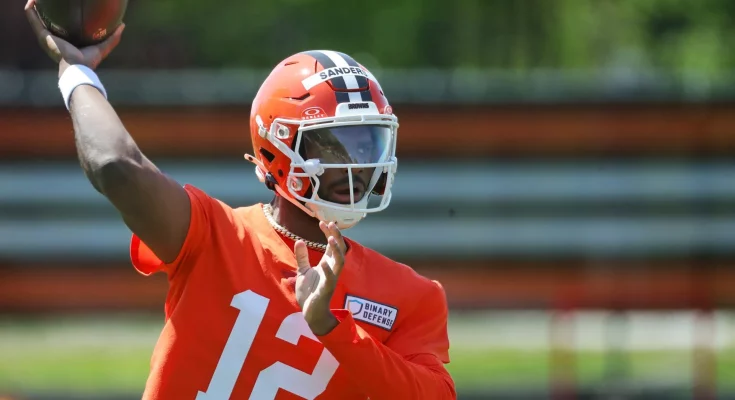The Cleveland Browns’ quarterback room has become a revolving door this offseason, a situation that reached a new level of intrigue with the recent report of the team signing Tyler Huntley, their sixth quarterback. The move, coming amidst a string of injuries to several of the team’s signal-callers, has sent a clear message: the Browns are prioritizing healthy bodies and a sense of stability as they head into a crucial part of training camp and the preseason. While the addition of a sixth quarterback might seem excessive, a closer look at the current state of the Browns’ roster reveals the logic behind the decision.
The Browns’ quarterback saga began long before the signing of Huntley. Their intended franchise quarterback, Deshaun Watson, is sidelined for the season with a second Achilles tendon tear, leaving a gaping hole at the top of the depth chart.1 This injury set off a chain reaction of moves, as the team sought to fill the void with a combination of seasoned veterans and promising rookies. The veteran presence was initially anchored by Joe Flacco, the 40-year-old signal-caller who earned a Pro Bowl selection after a late-season surge the previous year. He was joined by former Pittsburgh Steelers and Super Bowl champion Kenny Pickett, who was brought in to compete for the starting job. The rookie class was rounded out by third-rounder Dillon Gabriel and fifth-rounder Shedeur Sanders, the son of NFL legend Deion Sanders.2
On paper, this was a crowded but competitive room, a situation that would seemingly resolve itself through a natural process of competition during training camp. However, reality has proven to be far more complicated. Injuries have quickly derailed the best-laid plans. Pickett has been dealing with a hamstring injury that has limited his participation in team drills. Gabriel is also nursing hamstring tightness, while Sanders has been managing arm soreness. These setbacks have left Flacco as the only fully healthy quarterback, a precarious position for a team with high aspirations.3
The signing of Tyler Huntley is a direct response to this cascade of injuries. The team needed a healthy arm for their upcoming joint practices with the Carolina Panthers and their first preseason game. Huntley is a familiar face to the Browns, having spent last year’s training camp with the team before being released.4 His experience, particularly as a former Pro Bowler and long-time backup for Lamar Jackson in Baltimore, makes him a valuable addition in a pinch. He brings a dual-threat skill set and a familiarity with an offense similar to what the Browns run, providing a much-needed level of competency and stability.
Huntley’s career statistics paint a picture of a capable backup. He has a career completion percentage of 64.6%, with 2,786 passing yards, 11 touchdowns, and 10 interceptions. He is also a threat with his legs, having added 644 rushing yards and five touchdowns. His ability to extend plays and create opportunities outside the pocket is a welcome sight for a team in need of playmakers. He also brings a winning pedigree, having led the Miami Dolphins to a 2-3 record in five starts last season while their starting quarterback was out with an injury.5
The move to sign Huntley has also ignited speculation about the future of the other quarterbacks on the roster. With six quarterbacks now vying for a spot on the 53-man roster, it is highly likely that some of them will be on the move before the regular season begins. The NFL’s roster rules allow for a maximum of three active quarterbacks on game day, with a third being designated from the inactive list. This makes the prospect of keeping more than four quarterbacks on the regular season roster highly improbable. The addition of Huntley, a veteran with a proven track record, could signal that the team is preparing to move on from one of their other quarterbacks, with Pickett and rookie Dillon Gabriel being mentioned as potential trade options.
The situation is particularly interesting for Shedeur Sanders. As a fifth-round pick and the son of a football icon, he has a high profile and a lot of potential. However, the signing of Huntley could be interpreted as a sign that the Browns are not yet confident in their rookie’s readiness to contribute, especially with his recent arm soreness. Some reports even suggest that Sanders could be a “movable asset” in a trade, as other teams in need of a young quarterback might be interested in his potential and star power.
Ultimately, the signing of Tyler Huntley is a testament to the unpredictable nature of the NFL. What started as a competitive quarterback room has devolved into a carousel of injuries, forcing the team to make a calculated move to ensure they have enough healthy players to run a full practice and play a preseason game. While the future of the other quarterbacks remains uncertain, the addition of Huntley provides a temporary solution to a pressing problem and adds another layer of intrigue to an already fascinating quarterback battle in Cleveland. The move is a classic example of a team adapting to adversity, and it will be interesting to see how the situation unfolds as the season draws closer.



